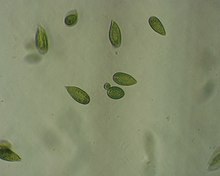| Raphidophytes | |
|---|---|

| |
| Gonyostomum semen | |
| Scientific classification | |
| Domain: | Eukaryota |
| Clade: | Diaphoretickes |
| Clade: | SAR |
| Clade: | Stramenopiles |
| Phylum: | Gyrista |
| Subphylum: | Ochrophytina |
| Class: | Raphidomonadea |
| Subclass: | Raphidophycidae Cavalier-Smith & Scoble, 2013 |
| Order: | Chattonellales Throndsen in Tomas, 1993 emend. Yamaguchi, Nakayama, Murakami & Inouye, 2010 |
| Synonyms | |
The raphidophytes, formally known as Raphidophycidae or Raphidophyceae (formerly referred to as Chloromonadophyceae and Chloromonadineae), are a small group of eukaryotic algae that includes both marine and freshwater species. All raphidophytes are unicellular, with large cells (50 to 100 μm), but no cell walls. Raphidophytes possess a pair of flagella, organised such that both originate from the same invagination (or gullet). One flagellum points forwards, and is covered in hair-like mastigonemes, while the other points backwards across the cell surface, lying within a ventral groove. Raphidophytes contain numerous ellipsoid chloroplasts, which contain chlorophylls a, c1 and c2. They also make use of accessory pigments including β-carotene and diadinoxanthin. Unlike other heterokontophytes, raphidophytes do not possess the photoreceptive organelle (or eyespot) typical of this group.
In terms of ecology, raphidophytes occur as photosynthetic autotrophs across a range of aquatic systems. Freshwater species are more common in acidic waters, such as pools in bogs. Marine species often produce large blooms in summer, particularly in coastal waters. Off the Japanese coast, the resulting red tides often cause disruption to fish farms, although raphidophytes are not usually responsible for toxic blooms.
The position of this group varied in former classifications. Some protozoologists treated the chloromonads as an order within the phytoflagellates. Some phycologists classified them with the Xanthophyceae and the Eustigmatophyceae in the division Xanthophyta. Others considered them as related to the Chrysophyceae, Dinophyceae, or Cryptophyceae Currently, raphidophytes are regarded as an independent lineage of algae within the class Raphidomonadea, which also includes the heliozoan group Actinophryida.
Taxonomy
The classification based on Cavalier-Smith and Scoble 2013 recognizes only one order, Chattonellales.
- Subclass Raphidophycidae Cavalier-Smith 2013
- Order Chattonellales Throndsen in Tomas, 1993 emend. Yamaguchi, Nakayama, Murakami & Inouye, 2010
- Genus Viridilobus Demir-Hilton et al. 2012
- Family Fibrocapsaceae Cavalier-Smith 2013
- Genus Fibrocapsa Toriumi & Takano 1973
- Family Haramonadaceae Cavalier-Smith 2013
- Genus Haramonas Horiguchi 1996
- Family Vacuolariaceae Luther, 1899 emend. Yamaguchi, Nakayama, Murakami & Inouye, 2010
- Genus Oltmannsia Schiller 1925
- Genus Chlorinimonas Yamaguchi et al. 2010
- Genus Heterosigma Hada 1967 ex Hara & Chihara 1987
- Genus Chattonella Biecheler 1936
- Family Vacuolariaceae
- Genus Swirenkoiamonas Skvortzov 1968
- Genus Vacuolaria Cienkowski 1870
- Genus Merotricha Mereschkowsky 1877
- Genus Gonyostomum Diesing 1866
- Order Chattonellales Throndsen in Tomas, 1993 emend. Yamaguchi, Nakayama, Murakami & Inouye, 2010
References
- ^ Cavalier-Smith, T; Scoble, J. M. (2013). "Phylogeny of Heterokonta: Incisomonas marina, a uniciliate gliding opalozoan related to Solenicola (Nanomonadea), and evidence that Actinophryida evolved from raphidophytes". European Journal of Protistology. 49 (3): 328–353. doi:10.1016/j.ejop.2012.09.002. PMID 23219323.
- Cavalier-Smith, Thomas (2017). "Kingdom Chromista and its eight phyla: a new synthesis emphasising periplastid protein targeting, cytoskeletal and periplastid evolution, and ancient divergences". Protoplasma. 255 (1): 297–357. doi:10.1007/s00709-017-1147-3. PMC 5756292. PMID 28875267.
- Herbert Graffius, J. (1966). "Additions to Our Knowledge of Michigan Pyrrhophyta and Chloromonadophyta". Transactions of the American Microscopical Society. 85 (2): 260–270. doi:10.2307/3224637. JSTOR 3224637.
- Hoek, C. van den; Mann, D. G.; Jahns, H. M. (1995). Algae: An introduction to phycology. UK: Cambridge University Press. ISBN 978-0-521-31687-3.
- "RAPHIDIOPHYTA". susqu.edu.
- American Water Works Association (2010). Algae: Source to Treatment. p. 281. ISBN 978-1-61300-116-5.
- Potter, D; Saunders, G; Andersen, R (1997). "Phylogenetic relationships of the Raphidophyceae and Xanthophyceae as inferred from nucleotide sequences of the 18S ribosomal RNA gene". American Journal of Botany. 84 (7): 966. doi:10.2307/2446287. JSTOR 2446287. PMID 21708651.
- ^ Yamaguchi, Haruyo; Nakayama, Takeshi; Murakami, Akio; Inouye, Isao (2010). "Phylogeny and taxonomy of the Raphidophyceae (Heterokontophyta) and Chlorinimonas sublosa gen. et sp. nov., a new marine sand-dwelling raphidophyte". Journal of Plant Research. 123: 333–342. doi:10.1007/s10265-009-0281-1.
| Taxon identifiers | |
|---|---|
| Raphidophyceae | |
| Chattonellales | |